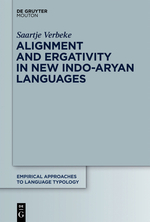Verbeke: Alignment and Ergativity
Verbeke, Saartje:
Alignment and Ergativity in New Indo-Aryan Languages / Saartje Verbeke. - Berlin ; Boston : W. de Gruyter Mouton, 2013. - XI, 320 S. - (Empirical Approaches to Language Typology [EALT] : 51)
Hochschulschrift. Teilw. zugl.: Gent, Univ., Diss., 2011
ISBN 978-3-11-029253-4
EUR 99,95 / US$ 140,00 (Print-Ausg.)
ISBN 978-3-11-029267-1
EUR 99,95 / US$ 140,00 (eBook)
DDC: 491.4
-- Angekündigt für März 2013 --
Beschreibung
The volume investigates the different alignment patterns in Indo-Aryan and shows that the variation of alignment patterns in Indo-Aryan goes beyond the opposition between accusativity and ergativity. The book includes a thorough discussion of the concepts and terminology relating to alignment patterns.
The study draws extensively on new language data from Indo-Aryan. It includes discussions of examples taken from Hindi, Sanskrit, Apabhramsa, Asamiya, Bangla, Oriya, the Bihari languages, Nepali, Kashmiri, Sindhi, Siraiki, Poguli, Gujarati, Punjabi, Marwari, Harauti, the Hindi varieties, and Shina. The volume offers a comprehensive overview of various alignment patterns in Indo-Aryan based on a wide range of data. By focusing on lesser known Indo-Aryan languages, the study questions the central position of Hindi-Urdu in the research on ergativity. Each language is treated in its own right, with a focus on language-specific data and analyses, rather than relying on a notional format that starts with pre-established linguistic concepts. In accordance with this methodology, much attention is paid to "indirect" connections between ergative constructions and other syntactic and semantic patterns in the various languages. [Verlagsinformation]
Inhalt
Acknowledgments. ix
List of Abbreviations. x
Introduction. 1
1. Theoretical preliminaries. 8
1.1 Ergativity from a functional and typological perspective. 8
1.2 Direct and indirect motivations of ergativity. 44
1.3 Conclusions. 63
2. Indo-Aryan. 65
2.1 Geographical distribution of the Indo-Aryan languages. 65
2.2 Alignment in Hindi. 68
2.3 Origin of the ergative pattern in Indo-Aryan. 75
2.4 Some key concepts of the Indo-Aryan languages. 89
3. Eastern Indo-Aryan: Asamiya. 111
3.1 Asamiya: description. 113
3.2 The transitive verb. 127
3.3 Ergative marking in Eastern Indo-Aryan. 142
3.4 Conclusion. 144
4. Northern Indo-Aryan: Nepali. 146
4.1 Nepali: description. 147
4.2 Reanalysis and extension of the postposition le. 156
4.3 Language contact. 170
4.4 Conclusion: alignment in Nepali. 173
5. Western Indo-Aryan: Kashmiri. 175
5.1 Kashmiri: description. 176
5.2 Pronominal suffixes in Western Indo-Aryan. 188
5.3 Second person importance: hierarchical relations and Marathi. 206
5.4 Conclusion. 208
6. Central Indo-Aryan: Rajasthani. 212
6.1 Description of Marwari. 213
6.2 Differential marking. 218
6.3 Central Indo-Aryan and Hindi: variation on a micro-scale. 240
6.4 Central Indo-Aryan: Conclusion. 246
7. Conclusion. 248
7.1 The definition of ergativity: summary. 248
7.2 Splits. 251
7.3 Core arguments and grammatical relations. 261
7.4 The motivation of the ergative pattern in Indo-Aryan. 263
7.5 Final observations. 266
8. Appendix. 268
9. References. 296
Index of Subjects. 316
Index of Languages. 320
Vollständiges Inhaltsverzeichnis
W. De Gruyter
Autorin
Saartje Verbeke, Postdoctoral Fellow of the Research Foundation Flanders (FWO-Vlaanderen), Belgium. Profile page.
Quellen: W. de Gruyter; Deutsche Nationalbibliothek; Buchhandel.de; Open ISBN; Amazon (DE); Lehmanns Media
Bildquelle: W. de Gruyter
Bibliographie: [1]
References
- (2013). Alignment and Ergativity in New Indo-Aryan Languages. Empirical Approaches to Language Typology [EALT]; 51. XI, 320 S.
Ähnlich
- Mylius: Lehrbuch der Ardhamāgadhī
- Vedic and Sanskrit Historical Linguistics
- Mylius: Zur Didaktik mittelindischer Sprachen
- Modi: Some Issues in Gujarati Phonology
- Indic across the Millennia
- Poudel: Eastern Nepali Grammar
- Linguistic Developments along the Silkroad
- A Grammar of Domari
- Grammar of Hadoti
- Bengali

